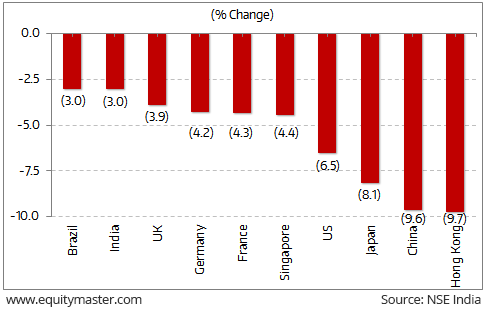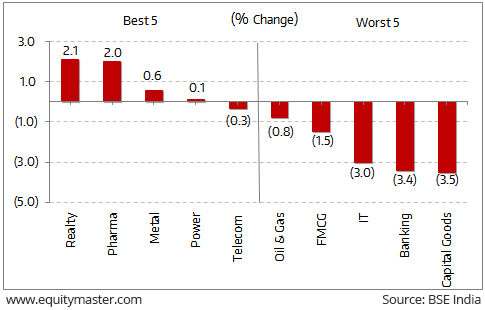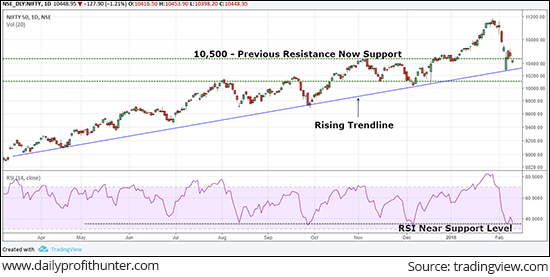- Home
- Todays Market
- Indian Stock Market News February 10, 2018
Carnage in Global Stock Market Continues Sat, 10 Feb RoundUp
Global stock markets were spooked again by the sell-off in the US markets. In the week gone by, the US stock markets continued to slide on growing uncertainty that the US Federal Reserve will raise interest rates faster than expected. Further strengthening bond yields in the US signal at higher rates that can push up borrowing costs, hurt corporate profits and curb economic activity. Another point of concern is a government budget proposal announced by US lawmakers, which raises spending caps thereby fanning inflation.
Dow's decline by 1,175 points on Monday was the steepest in percentage terms since August 2011, when markets dropped in the aftermath of "Black Monday" - the day Standard & Poor's downgraded its credit rating of the US. Yet again on Thursday, the Dow slumped by over 1,000 points sparking a sharp pull-back on stocks across the world markets.
Apart from the US Federal Reserve, even the Bank of England has hinted towards an uptrend in interest rates. The Bank left interest rates at 0.5% at its meeting, but said a strengthening economy meant interest rates were likely to rise sooner than the markets were expecting.
Back home, global cues weighed down and the index posted a second straight weekly fall after scaling new highs in January. BSE-Sensex ended the week on a negative note and fell 3% to 34,006 this week. Meanwhile, the BSE MidCap was up 0.4% and BSE SmallCap increased 1.8% in the past week.
Key World Markets During the Week

On the sectoral indices front, stocks from capital goods, banking and IT witnessed maximum selling pressure in the week gone by.
BSE Indices During the Week

Now let us discuss some key economic and industry developments during the week gone by.
In its monetary policy, the RBI kept the repo rate unchanged at 6%. With this, the policy rate stands at a seven-year low. The MPC committee had last cut the repo rate by 25 basis points in August last year. As for inflation, the RBI raised its March-end Consumer Price Index (CPI) inflation forecast to 5.1% and projected an inflation range of 5.1-5.6% in the first half of the next fiscal year.
Notebandi and goods and service tax, two major reforms carried out by the government are gradually beginning to yield results. After November 2016, 10.1 million tax filers were added compared to an average of 6.2 million in the preceding six years. Further analysis suggests that new filers reported an average income, in many cases, close to the income tax threshold of Rs. 2.5 lakh, limiting the early revenue impact. As income growth pushes many of the new tax filers in time over the threshold, the revenue dividends should increase robustly.
Since the launch of Goods and Services Tax (GST), there were 9.8 million unique GST registrants, an increase of 50% compared to the previous tax regime. There has also been a large increase in voluntary registrations, especially by small enterprises that buy from large enterprises wanting to avail themselves of input tax credits.
Gold imports remained weak on low demand. Provisional data from precious metals consultancy GFMS and bank dealers showed India's gold imports in January dropped to their lowest in 17 months as prices rebounded and buyers postponed purchases on expectations of import tax cuts. The fall in imports by India, the world's second-biggest consumer of gold after China, could weigh on global prices, which have risen over 7% in the past few weeks.
The telecom sector, reeling under huge debt and disruptive competition with the entry of Reliance Jio, is witnessing consolidation. Last year, Vodafone and Idea announced a merger that will create the country's biggest telecom services company. Bharti has taken over Tata Teleservices' consumer mobile services and Norway-based Telenor's Indian arm, Uninor.
UK's Vodafone is in the final stages of talks to sell its entire 42% stake in Indus Towers for about US$5 billion, raising Bharti Infratel's holding in the company to 84% through a share-swap deal. Reportedly, Vodafone's stake is pegged at around US$5 billion. However, the final number will be an outcome of the impact of tower cancellations that will arise once the different telcos consolidate the overlapping tenancies.
Bharti Infratel, a subsidiary of Bharti Airtel owns 42% in the Indus Towers joint venture. While Idea Cellular has a 16% share in it. The no-cash transaction, involving a share swap, will see Vodafone getting a smaller pie of the combined Bharti Infratel. Along with these mergers comes the sector's anticipated reduction in infrastructure and people overlaps. Indus Towers had 122,920 telecom towers at the end of June 2017, with 297,867 slots on rent.
Movers and shakers during the week
| Top Gainers During the Week (BSE Group A) | ||||
|---|---|---|---|---|
| Company | 1-Feb-18 | 9-Feb-18 | Change | 52-wk High/Low |
| IPCA Labs | 563.15 | 620.00 | 10.1% | 656/400 |
| Ashok Leyland | 123.45 | 134.45 | 8.9% | 137/81 |
| Castrol India | 183.8 | 196.90 | 7.1% | 227/7 |
| Cipla | 586.75 | 625.50 | 6.6% | 663/479 |
| Bhushan Steel | 49.90 | 53.00 | 6.2% | 103/39 |
| Top Losers During the Week (BSE A Group) | ||||
| IFCI | 28.2 | 23.4 | -17.0% | 35/21 |
| *Bayer Cropscience | 4,571.85 | 3,900 | -14.7% | 5,050/3,685 |
| *Jaiprakash Associates | 20.4 | 17.45 | -14.5% | 30/9 |
| *GMR Infra | 22.75 | 19.6 | -13.8% | 25/14 |
| Oberoi Realty | 521.9 | 455.85 | -12.7% | 562/319 |
Some of the key corporate developments in the week gone by.
Cipla reported a 4.8% growth year-on-year in profit at Rs 4 billion in Q3FY18. The growth was largely supported by better-than-expected operational performance and tax reversal but restricted due to lower other income.
Tata Motors' third quarter consolidated earnings were impacted by weak Jaguar Land Rover show; but standalone or domestic business reported healthy performance backed by strong commercial vehicle segment performance and cost reduction efforts. Net profit rose to Rs 12.14 billion for the three months ended December from Rs 1.11 billion in the same period a year earlier, the biggest jump in seven quarters.
Sales in JLR unit rose just 3.45% from a year ago to 154,447 units. While sales in the US and Europe declined, sales growth in China slowed to 14.6%. JLR's sales were weighed by few launches and model refreshes during the year. The company expects to maintain an Ebitda margin of 8-10% in the medium term.
Tata Motors' passenger and commercial vehicle business performance was strong for the quarter as standalone profit stood at Rs 1.83 billion in Q3 against loss of Rs 10.45 billion in same period last year.
In another development, Tata Motors Ltd and Warburg Pincus Llc have mutually agreed to call off the US private equity firm's proposed investment of around US$360 million in Tata Technologies Ltd. Due to delays in securing regulatory approvals as well as due to the recent performance of the company not meeting internal thresholds because of market challenges, the parties mutually decided not to proceed.
M&M has sought board approval to invest around Rs 8 billion to develop two new electric vehicle (EV) products and set up a research and development Centre for such vehicles. M&M, which has so far invested Rs 6 billion in its electric venture, plans to raise EV capacity to 1000 units a month by end-2018 from about 200 units now, and 5,000 by 2020. If everything goes as planned, M&M could be selling 60,000 EVs annually by 2020, and if that makes up a quarter of the market, that would mean a total EV market size of 250,000.
Even Ashok Leyland is reportedly planning to invest around Rs 1 billion in the electric vehicle (EV) technology over the next two-three years. The company is also planning to showcase the prototype of its first EV product at the upcoming Auto Expo 2018, scheduled to start this week in New Delhi. The company's total planned capital expenditure for the 2018-19 financial year, including the expense of expanding its cabin facility, debottlenecking and investment in technologies, would be Rs 5-7 billion.
Currently, electric vehicle sales are low in India, rising 37.5% to 22,000 units in the year ended 31 March 2016 from 16,000 in 2014-15. Only 2,000 of these were cars and other four-wheelers, according to automobile lobby group Society of Indian Automobile Manufacturers (Siam).
The government wants to see 6 million electric and hybrid vehicles on Indian roads by 2020 under the National Electric Mobility Mission Plan 2020. The government is targeting to have all cars propelled by electric engine by 2030. The target is more daunting than in many advanced countries.
Bharti Airtel's quarterly profit plunged 39% to Rs 3.06 billion in the December 2017 quarter. The dismal performance is due to mounting pressures on the revenue front as the pricing war triggered by the entry of Reliance Jio Infocomm showed no signs of abating. The telecom regulator has more than halved interconnection fees that has been a further drag on the company's topline. Airtel's net debt as of 31 December was Rs 917.13 billion, up from Rs 914.80 billion as of 30 September.
Singapore Telecommunications Ltd (Singtel) will indirectly raise its stake in Bharti Airtel Ltd by investing Rs 26.49 billion in Bharti Telecom Ltd, the promoter company of Airtel, through a preferential allotment of shares.
With this investment, Singtel's total stake (along with its affiliates) in Bharti Telecom will increase to 48.9%. Singtel currently holds 47.17% stake in Bharti Telecom. Bharti Enterprises continues to hold over 50% stake in Bharti Telecom. The investment comes within 23 months of Singtel's participation in Bharti Telecom's Right Issue of Rs 25 billion, which was completed in February 2016.
Coming to the issue of bad loan resolution, Bhushan Steel with a Rs 440 billion default, is the biggest bankruptcy to go under the hammer thus far after the Reserve Bank of India and the government pushed banks to clean up the bad loan mess through the Insolvency and Bankruptcy Code (IBC). As many as 451 cases with an exposure of Rs 1.28 trillion are pending in the bankruptcy courts. Essar Steel and Electrosteel Steels are the other big metal companies undergoing the bankruptcy process.
Bidding for Bhushan has witnessed some twists in the past month with many global giants showing initial interest then withdrawing from the race. JSW Steel, Tata Steel and a group of employees along with a private equity firm have submitted bids for the bankrupt Bhushan Steel. JSW Steel had submitted its bid along with Piramal Enterprises' distressed asset fund after Japanese company JFE Steel Corp bowed out at the last moment.
Bhushan Steel has an annual steel capacity of 5 million tonnes. The resolution professional has set the liquidation value at Rs 150 billion, below which no bid will be accepted. Most bids are expected to be in the Rs 250-300 billion range.
GAIL (India) Limited has placed an order of Rs 4.4 billion for laying of approximately 350 kms of pipeline from Vijaipur (in the state of Madhya Pradesh) to Auraiya (in the state of Uttar Pradesh). This is a part of approximately 665 km length from Vijaipur to Phulpur to the existing HVJ-DVPL upgradation pipeline system. Reportedly, this pipeline shall provide the gas feed to the ongoing 2,655 Km long Jagdispur-Haldia-Bokaro-Dhamra pipeline (JHBDPL) project of GAIL.
The JHBDPL will pass through the state of Uttar Pradesh, Bihar, Jharkhand, West Bengal and Odisha, and the project is progressing in full swing which will usher industrial development in eastern India by supplying environmentally clean natural gas to fertilizer and power plants, refineries, steel plants, city gas distribution and other industries.
One shall note that, GAIL has awarded contracts of Rs 54 billion in the current fiscal year which includes Rs 35 billion for procurement of pipeline and Rs 19 billion for laying of pipes. Further, GAIL has awarded till date contracts worth Rs 75 billion for ongoing pipeline projects of around 4,000 kms in south and eastern India.
Emami has concluded a deal to acquire a substantial minority stake in Brillare Science Pvt. Ltd, valuing the company at Rs 750 million-1 billion. Brillare produces hair and skin care products, and sells them to professional salons. Emami currently does not sell through grooming salons but according to Brillare's director, the company may bring these products within its own distribution network to supply to premium outlets going ahead.
In early December, Emami announced it had agreed to acquire a 30% stake in another new consumer goods maker, Helios Lifestyle Pvt. Ltd, which sells upscale men's grooming products under The Man Company brand.
Bangalore-based builder Prestige Estates Projects has entered into a strategic partnership with HDFC Capital Advisors to support its business in the mid-Income and affordable housing segment. This dedicated real estate platform will have a capital to the tune of Rs 25 billion, which will be combination of equity and debt.
The primary focus of this platform will be on expanding the builder's residential business by identifying strategic land parcels with the potential of developing large-scale residential projects in the mid- income segment.One shall note that, HDFC Capital has been offering long-term equity capital to select real estate developers, mainly to develop affordable housing, preferred by builders and investors alike.
Last October, Mahindra Lifespace Developers Ltd, the real estate arm of Mahindra Group, partnered with HDFC Capital to jointly invest Rs500 crore over the next three years to develop affordable housing projects across geographies.
And here's an update from our friends at Daily Profit Hunter...
The Nifty 50 Index witnessed extreme volatility during the week. On Monday, it opened the session 157 points gap down before recovering a bit to end the session 94 points down. The bears continue to dominate as the index opened 372 point gap down on the next day. It witnesses some short covering during the midweek. But the index again gap down 160 points on Friday and ended the weekly session 2.84% down.
As mentioned a week before, the correction in the Indian indices was inevitable as the RSI indicator was trading in its extreme overbought territory. Last week, the index slipped 300 points and this week it fell another 300 points.
As mentioned in our previous note, if the index keeps dropping, what happens at the 10,500 level, which is an important support, would an interesting thing to watch out for. The index slipped to a low of 10,276 but did not sustain down for long and recovered on the same day.
Currently, the index is again trading near the 10,500 support level. The index also found support from the rising trendline (blue line). The RSI indicator has also cooled off and is now trading near its support level.
If the index holds the 10,500 level, we could see the bulls getting back in action. On the flip side, if it does not hold the support level, the correction might continue for some more time.
Stay tuned...we'll fill you in next week. You can read the entire stock market commentary here.
Nifty 50 Index Tumbles 3% for the Week

For information on how to pick stocks that have the potential to deliver big returns, download our special report now!
Read the latest Market Commentary


Equitymaster requests your view! Post a comment on "Carnage in Global Stock Market Continues". Click here!
Comments are moderated by Equitymaster, in accordance with the Terms of Use, and may not appear
on this article until they have been reviewed and deemed appropriate for posting.
In the meantime, you may want to share this article with your friends!